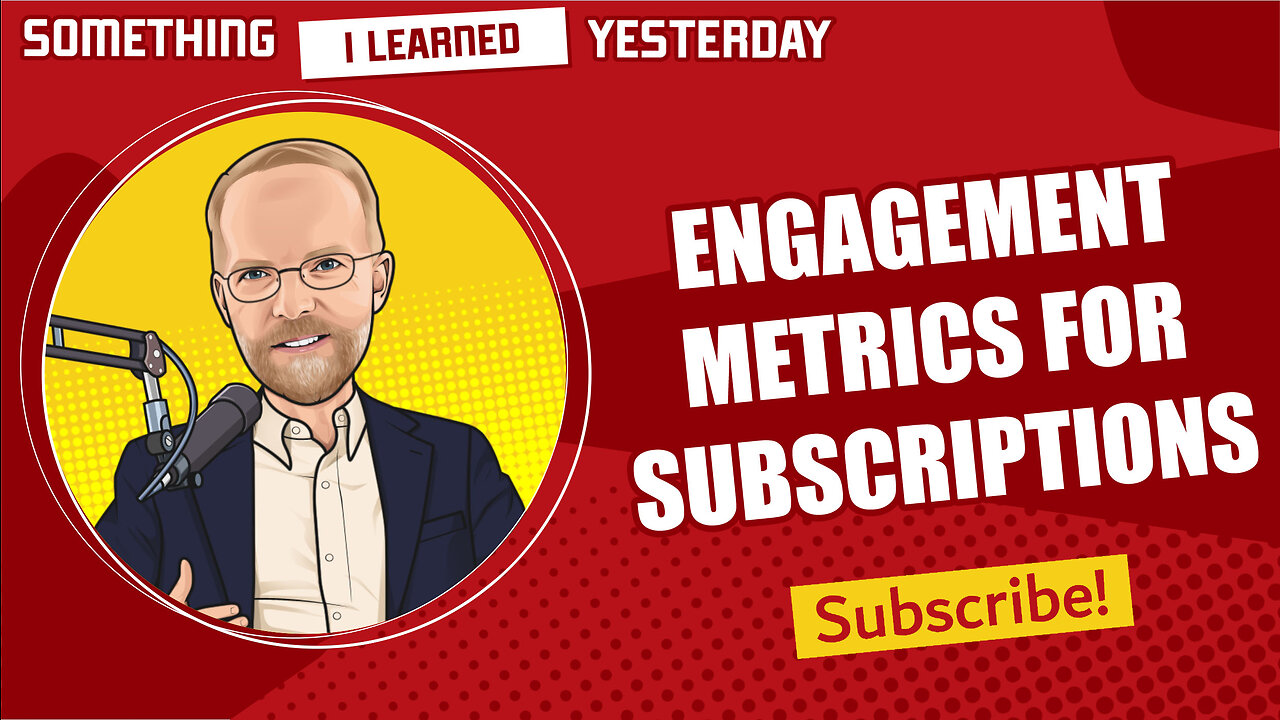Premium Only Content

131: Engagement metrics for subscription websites
What kinds of engagement metrics are associated with a propensity to subscribe?
I signed up for The Audiencers email, and the welcome email pointed me to this great article: “Ask the experts: what are the most valuable engagement metrics to measure in a subscription model?”
It’s a crucial topic because people talk a lot about “engagement,” but it’s often not exactly sure what they mean by that. You can measure engagement a lot of different ways. Which are the ones that are key to a subscription model?
You should read the article yourself, but I’m going to pull out a few points that I found interesting.
Distinguish content engagement with propensity to subscribe. In other words, a person can be very engaged with your content and never have any intention of subscribing, while another person might take specific actions that are highly correlated with subscribing.
An example is e-newsletter sign-up. If e-newsletters are sent at a set time, on a set frequency, this can form a habit, which is the kind of engagement you want.
You’ve also created a direct relationship with that customer. Rather than waiting for them to come to you, you can go to them.
Registration is also valuable. People who register are far more likely to subscribe than anonymous people.
This next one surprised me a little, but it makes sense. Exposing readers to a diverse array of topics and authors is better for promoting subscriptions. You don’t want your content-recommendation engine to send people down a spiral – always showing them the same topic.
Time spent on your website or app is also a good predictor of conversion. “The conversion probability increases by 130 times if the media time increases by 10 minutes per week. The churn probability is halved if the media time increases by 10 minutes per week.”
It’s important to remember that “engagement” really isn’t the goal. The goal is to get a loyal subscriber. So a “back-to-front” approach is to find out what your loyal subscribers do and focus on those actions – i.e., presumably, trying to get other people to behave the same way.
The Lenfest Institute found that readers are more likely to become subscribers when they read 5+ articles per month or provide their email address.
The article includes a chart that maps various actions to increased likelihood to subscribe.
Reads 5+ articles / month or has provided an email come in top at 5x to 10x.
Follows your brand on social media is next at 4x to 6x.
Reading multiple categories of content, accessing your content across multiple platforms, or lives in your market area and reads local news all give a 2x to 3x boost.
This is all great stuff, and I encourage you to read the article, but there’s a logical issue that I’m struggling with.
Let’s say you find that your faithful, long-time subscribers are far more likely to sign up for your e-newsletter. Does it follow that promoting your e-newsletter is going to transform those new sign-ups into faithful, long-time subscribers?
That doesn’t follow. You’ve changed the conditions of the test.
I do believe it’s a good idea to promote the kind of behaviors that are associated with long-term customer value. But I suspect that as you do that, the numbers are going to change. That is, the commitment of the people who signed up for your e-newsletter before you started rigorously promoting it won’t be the same as the commitment of the latter group.
Resources
Ask the experts: what are the most valuable engagement metrics to measure in a subscription model?
https://theaudiencers.com/decisions/ask-the-experts-what-are-the-most-valuable-engagement-metrics-to-measure-in-a-subscription-model/
-
 8:31
8:31
MattMorseTV
23 hours ago $1.28 earnedTexas just did the IMPOSSIBLE.
55.7K72 -
 LIVE
LIVE
Rotella Games
16 hours agoGreen Hell Day 6 | We Have a LONG Way to Go
279 watching -
 LIVE
LIVE
Lofi Girl
2 years agoSynthwave Radio 🌌 - beats to chill/game to
403 watching -
 41:26
41:26
The Mel K Show
3 hours agoMel K & Clay Clark | Financial Success Hides Behind Self Discipline: Five Pillars | 8-24-25
15.3K2 -
 LIVE
LIVE
The Rabble Wrangler
11 hours agoThe Best in the West Plays Battlefield 2042 | Road to BF6 Grind
33 watching -
 LIVE
LIVE
JTtheSG
40 minutes agoBack To The Deadzone!!!
51 watching -
 LIVE
LIVE
The Official Steve Harvey
12 days ago $5.07 earned24 HOURS OF MOTIVATION w/ STEVE HARVEY
437 watching -
 25:56
25:56
DeVory Darkins
21 hours ago $0.66 earnedTrump drops ULTIMATE BOMB on Democrat Mayors as ICE makes SHOCKING Announcement
40.6K165 -
 3:36:30
3:36:30
TonYGaMinG
5 hours ago🟢 ABI WITH FRIENDS | 🍩JOE DONUTS | 😶 🌫 VLADSGAMINGCARTEL |
21.3K4 -
 21:24
21:24
marcushouse
12 hours ago $0.10 earnedStarship Flight 10: Go or No? 🚀
29.8K12